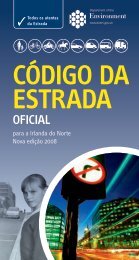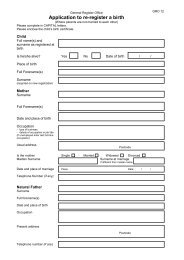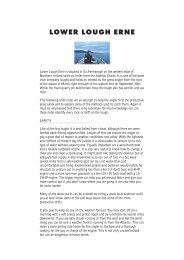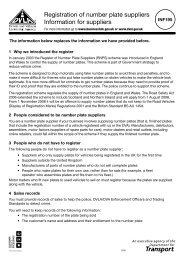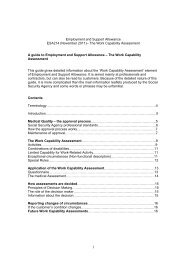an instructors guide to delivering compulsory basic training - NIDirect
an instructors guide to delivering compulsory basic training - NIDirect
an instructors guide to delivering compulsory basic training - NIDirect
Create successful ePaper yourself
Turn your PDF publications into a flip-book with our unique Google optimized e-Paper software.
2. CBT Syllabus<br />
that it requires great care <strong>an</strong>d c<strong>an</strong> expose a rider <strong>to</strong> additional hazards such as<br />
vehicles suddenly ch<strong>an</strong>ging l<strong>an</strong>e, sudden opening of doors, pedestri<strong>an</strong>s <strong>an</strong>d cyclists,<br />
vehicles emerging or turning at junctions, road markings or studs which could upset<br />
a rider’s bal<strong>an</strong>ce.<br />
You should also discuss with your pupils that when filtering, they need <strong>to</strong> ride slowly<br />
<strong>an</strong>d be prepared <strong>to</strong> s<strong>to</strong>p at <strong>an</strong>y time <strong>an</strong>d be ready <strong>to</strong> brake <strong>an</strong>d/or use the horn if<br />
they think he has not been seen.<br />
If in doubt do not filter.<br />
Incidents <strong>an</strong>d First Aid<br />
You should explain that if they are the first or among the first <strong>to</strong> arrive at the scene<br />
of a road traffic incident, they should remember that further collisions c<strong>an</strong>, <strong>an</strong>d do,<br />
happen, that fire is a major hazard <strong>an</strong>d that both incident victims <strong>an</strong>d helpers are in<br />
d<strong>an</strong>ger.<br />
You should also cover how they should react if their mo<strong>to</strong>rcycle breaks down on the<br />
move by explaining how <strong>to</strong> control the mo<strong>to</strong>rcycle in varying circumst<strong>an</strong>ces.<br />
You should inform your pupils how <strong>to</strong> warn other traffic by switching on hazard<br />
warning lights (if fitted) or other lights, by displaying <strong>an</strong> adv<strong>an</strong>ce warning tri<strong>an</strong>gle (if<br />
carried) or by using <strong>an</strong>y other me<strong>an</strong>s <strong>to</strong> warn other drivers.<br />
You should explain that they must switch off the engine <strong>an</strong>d warn others <strong>to</strong> do the<br />
same. Put out cigarettes or other fire hazards <strong>an</strong>d call the emergency services if<br />
necessary.<br />
When calling emergency services – a rider should give full details of the location <strong>an</strong>d<br />
casualties. On a mo<strong>to</strong>rway, this could me<strong>an</strong> going <strong>to</strong> the next emergency telephone.<br />
If a mobile phone is used <strong>to</strong> call the emergency services your pupils should make<br />
sure they are able <strong>to</strong> tell them exactly where they are. This is particularly import<strong>an</strong>t<br />
on a mo<strong>to</strong>rway where imprecise details c<strong>an</strong> cause great problems for the emergency<br />
services. Location details are given on marker posts located on the hard shoulder. A<br />
rider should always check these before he makes the call.<br />
The rider should move uninjured people away from the vehicles involved <strong>to</strong> a place<br />
of safety. On a mo<strong>to</strong>rway, this should be away from the carriageway, hard shoulder<br />
or central reservation.<br />
47



